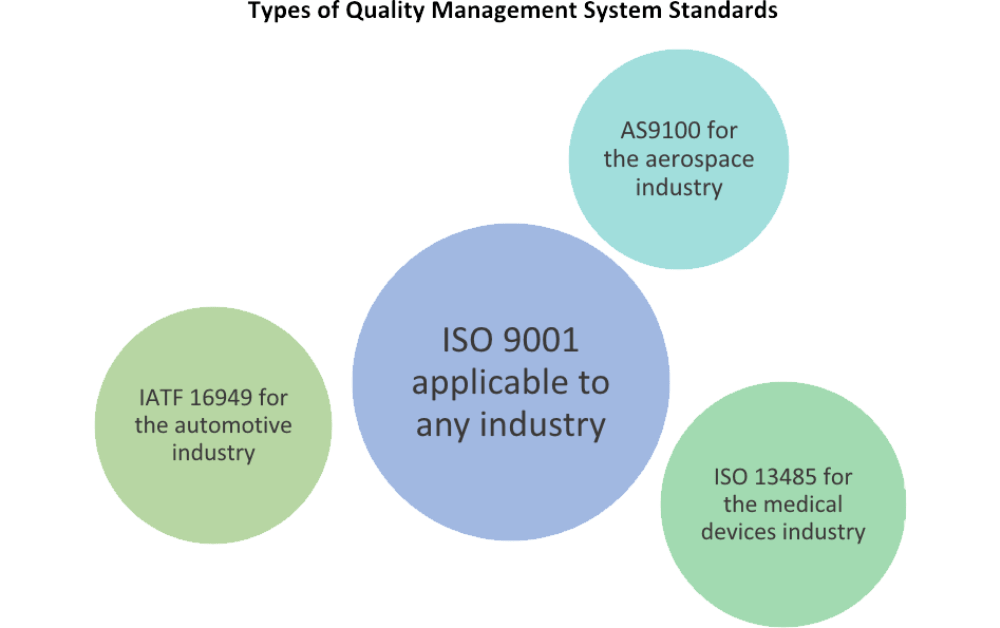A Quality Management System, often called a QMS, is a set of internal rules that are defined by a collection of policies, processes, documented procedures, and records. This system defines how a company will achieve the creation and delivery of the products and services they provide to their customers. When implemented in your company, the QMS needs to be specific for the product or service you provide, so it is important to tailor it to your needs. However, in order to help ensure that you do not miss elements of a good system, some general guidelines exist in the form of ISO 9001:2015 (Quality Management System – Requirements), which are intended to help standardize how a QMS is designed.
What is a Quality Management System according to ISO 9001?
ISO 9001 is an internationally recognized set of requirements for creating the rules, policies, processes, and procedures to provide products and services that meet customer needs, and improve customer satisfaction. The Quality Management System standard is maintained by the International Organization for Standardization, and is agreed upon by a majority of member countries in this organization so that it can be recognized internationally and is accepted as the gold standard for the processes to be used worldwide for the QMS.
What are the seven quality management principles?
The ISO 9001 Quality Management System is based on seven principles, each one a critical focus for a system QMS. These seven principles are:
- Customer focus. If you are trying to provide products and services that meet customer needs, you first need to be focused on what these needs are. This customer focus is the foundation of improving customer satisfaction.
- In order for the QMS to succeed, top management needs to provide resources and adequate ongoing review of the system.
- Engagement of people. The people who work at your organization are the most important asset, and their knowledge and experience need to be understood in the QMS.
- Process approach. A process is any activity that takes inputs, and creates outputs; these inputs and outputs need not be simply physical; some are information or energy. Everything we do in an organization is a process, and a system is created when we understand that the inputs for one process come from a different process, and it is in these interactions that we need to take particular care.
- A company will only survive if it gets better over time, so the QMS needs to focus on finding ways to do things better.
- Evidence-based decision making. Proper management cannot be done if we don’t know how a process is actually working. By basing our decisions on facts, we can better manage and improve the QMS.
- Relationship management. Sometimes the only way to improve our products and services is to have our suppliers improve their products and services. In order to make this work, we need to manage the relationship between ourselves and our suppliers.
These Quality Management System principles are found in the document ISO 9000, which is a supporting document for the ISO 9001 requirements.
For more detail on the seven Quality Management System principles, see the article: Seven Quality Management Principles behind ISO 9001 requirements.
Why is the QMS important?
The QMS is important because it includes all of the activities that an organization does to provide products and services focused on the customer, and this is the reason why organizations are in business. A QMS that includes the necessary processes to meet this goal will help you to provide consistent results to your customers and other stakeholders, which will provide confidence in your organization and offer you the foundation for improvement and growth.
For this reason, it is advisable to create your QMS by implementing the requirements of a standard that is recognized as providing the agreed acceptable processes required to ensure customer satisfaction and improvement.
What are the different types of Quality Management Systems?
One of the best ways to ensure that your QMS has included all applicable processes is to refer to a standard set of requirements for Quality Management Systems. The ISO 9001 standard is one such set of requirements that is accepted worldwide, and which defines and outlines all the typical policies, processes, documented procedures, and records that are needed for a successful QMS, and can be used and tailored for the needs of any organization. ISO 9001 provides the best practices for a Quality Management System, including data management needs, and focuses on product quality and service quality to meet customer needs.
Other standards exist for the creation of a QMS in different specific industries, and these standards include: AS9100 for the aerospace industry, ISO 13485 for the medical devices industry, and IATF 16949 for the automotive industry.
Types of Quality Management System Standards
What all of these standards have in common is that they are based on the ISO 9001 standard; however, each has added additional requirements that are mandatory for its industry. Some of these standards include a quality manual as a necessary document, while others have removed this requirement along with the latest update to ISO 9001:2015. Note that the medical devices QMS requirements standard, ISO 13485, is aligned to a previous version of ISO 9001 and therefore includes this requirement for a quality manual.
Challenges of developing a QMS
Quality Management System development can sometimes be challenging. One of the first challenges to overcome is the misconception of thinking a QMS only refers to the processes necessary to deal with inspection and disposition of non-conforming products, often designated to members of a quality control department. Such a system only manages the inspection of product, while not managing the inputs that help a product or service to be compliant in the first place, effectively trying to inspect quality into the product or service.
The next big challenge in implementing the Quality Management System is demonstrating the commitment of management by having the overlying policies defined and communicated to all levels of the organization. Then the QMS can be made to work as a method of ensuring that all necessary requirements are defined and met, and improvements are made.
To see the detailed QMS requirements from ISO 9001, see the white paper: Clause-by-clause explanation of ISO 9001:2015.
About the author
Mark Hammar is a Certified Manager of Quality / Organizational Excellence through the American Society for Quality, and has been a Quality Professional since 1994. Mark has experience in auditing, improving processes, and writing procedures for Quality, Environmental, and Occupational Health & Safety Management Systems, and is certified as a Lead Auditor for ISO 9001, AS9100, and ISO 14001.


 Mark Hammar
Mark Hammar 






